George Brown College: BSBRSK501 Manage Risk Assessment Guide
VerifiedAdded on 2022/09/12
|27
|7962
|20
Homework Assignment
AI Summary
This assignment solution provides a comprehensive guide to the BSBRSK501 Manage Risk assessment. It includes an overview of the unit, assessment details, and specific requirements for both the written questions and the project component. The assessment tasks are divided into stages, with detailed instructions for each. The project involves developing a risk management strategy and plan for a hypothetical cafe, encompassing establishing the risk context, identifying risks, analyzing risks, selecting treatments, and developing an implementation strategy. The assessment also covers the key elements of current risk management standards and organizational policies. The solution highlights the importance of stakeholder consultation, action plan development, and evaluation of the risk management process. The assessment also emphasizes the importance of understanding the legislative and regulatory context of the organization in relation to risk management. The document also provides information on plagiarism, referencing, and assessment outcomes, including what happens if a student disagrees with the assessment result. The assessment also covers the various stages of the project, which includes describing the context of the planned business, performing a risk assessment and creating a risk management plan, and writing an action plan for implementation and monitoring. The final stage of the project involves developing a report evaluating the risk management processes based on a given scenario.
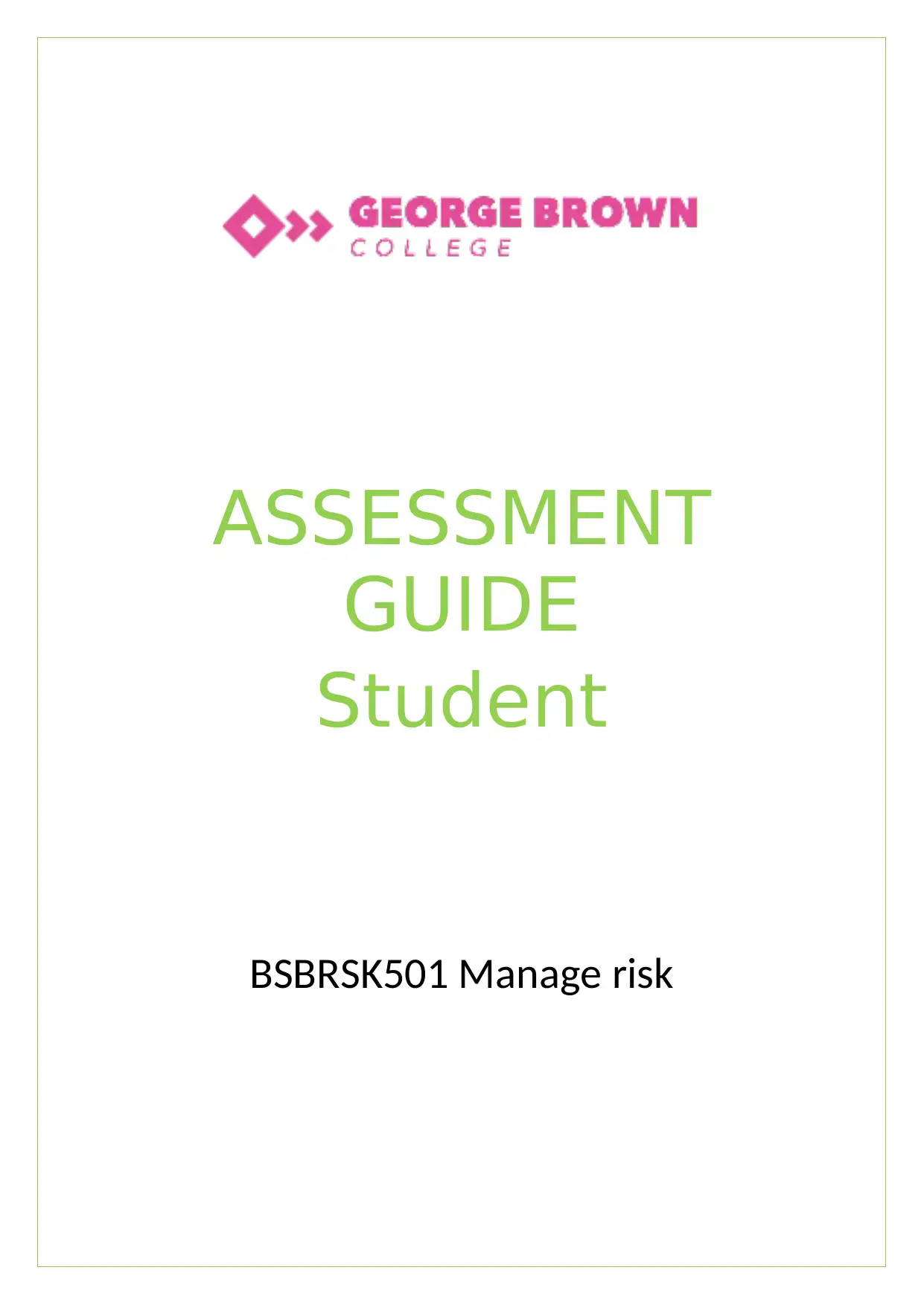
ASSESSMENT
GUIDE
Student
BSBRSK501 Manage risk
GUIDE
Student
BSBRSK501 Manage risk
Paraphrase This Document
Need a fresh take? Get an instant paraphrase of this document with our AI Paraphraser
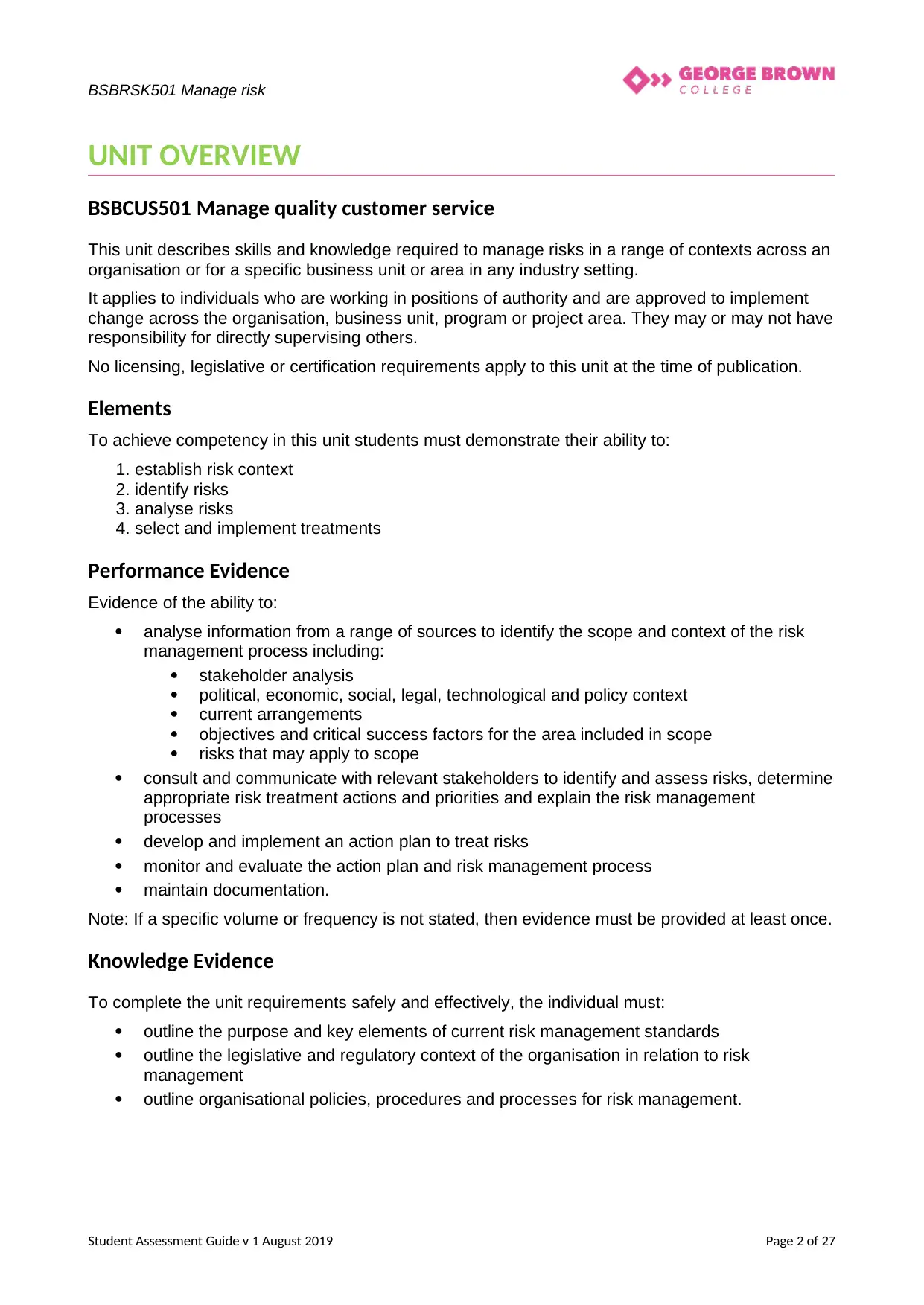
BSBRSK501 Manage risk
UNIT OVERVIEW
BSBCUS501 Manage quality customer service
This unit describes skills and knowledge required to manage risks in a range of contexts across an
organisation or for a specific business unit or area in any industry setting.
It applies to individuals who are working in positions of authority and are approved to implement
change across the organisation, business unit, program or project area. They may or may not have
responsibility for directly supervising others.
No licensing, legislative or certification requirements apply to this unit at the time of publication.
Elements
To achieve competency in this unit students must demonstrate their ability to:
1. establish risk context
2. identify risks
3. analyse risks
4. select and implement treatments
Performance Evidence
Evidence of the ability to:
analyse information from a range of sources to identify the scope and context of the risk
management process including:
stakeholder analysis
political, economic, social, legal, technological and policy context
current arrangements
objectives and critical success factors for the area included in scope
risks that may apply to scope
consult and communicate with relevant stakeholders to identify and assess risks, determine
appropriate risk treatment actions and priorities and explain the risk management
processes
develop and implement an action plan to treat risks
monitor and evaluate the action plan and risk management process
maintain documentation.
Note: If a specific volume or frequency is not stated, then evidence must be provided at least once.
Knowledge Evidence
To complete the unit requirements safely and effectively, the individual must:
outline the purpose and key elements of current risk management standards
outline the legislative and regulatory context of the organisation in relation to risk
management
outline organisational policies, procedures and processes for risk management.
Student Assessment Guide v 1 August 2019 Page 2 of 27
UNIT OVERVIEW
BSBCUS501 Manage quality customer service
This unit describes skills and knowledge required to manage risks in a range of contexts across an
organisation or for a specific business unit or area in any industry setting.
It applies to individuals who are working in positions of authority and are approved to implement
change across the organisation, business unit, program or project area. They may or may not have
responsibility for directly supervising others.
No licensing, legislative or certification requirements apply to this unit at the time of publication.
Elements
To achieve competency in this unit students must demonstrate their ability to:
1. establish risk context
2. identify risks
3. analyse risks
4. select and implement treatments
Performance Evidence
Evidence of the ability to:
analyse information from a range of sources to identify the scope and context of the risk
management process including:
stakeholder analysis
political, economic, social, legal, technological and policy context
current arrangements
objectives and critical success factors for the area included in scope
risks that may apply to scope
consult and communicate with relevant stakeholders to identify and assess risks, determine
appropriate risk treatment actions and priorities and explain the risk management
processes
develop and implement an action plan to treat risks
monitor and evaluate the action plan and risk management process
maintain documentation.
Note: If a specific volume or frequency is not stated, then evidence must be provided at least once.
Knowledge Evidence
To complete the unit requirements safely and effectively, the individual must:
outline the purpose and key elements of current risk management standards
outline the legislative and regulatory context of the organisation in relation to risk
management
outline organisational policies, procedures and processes for risk management.
Student Assessment Guide v 1 August 2019 Page 2 of 27
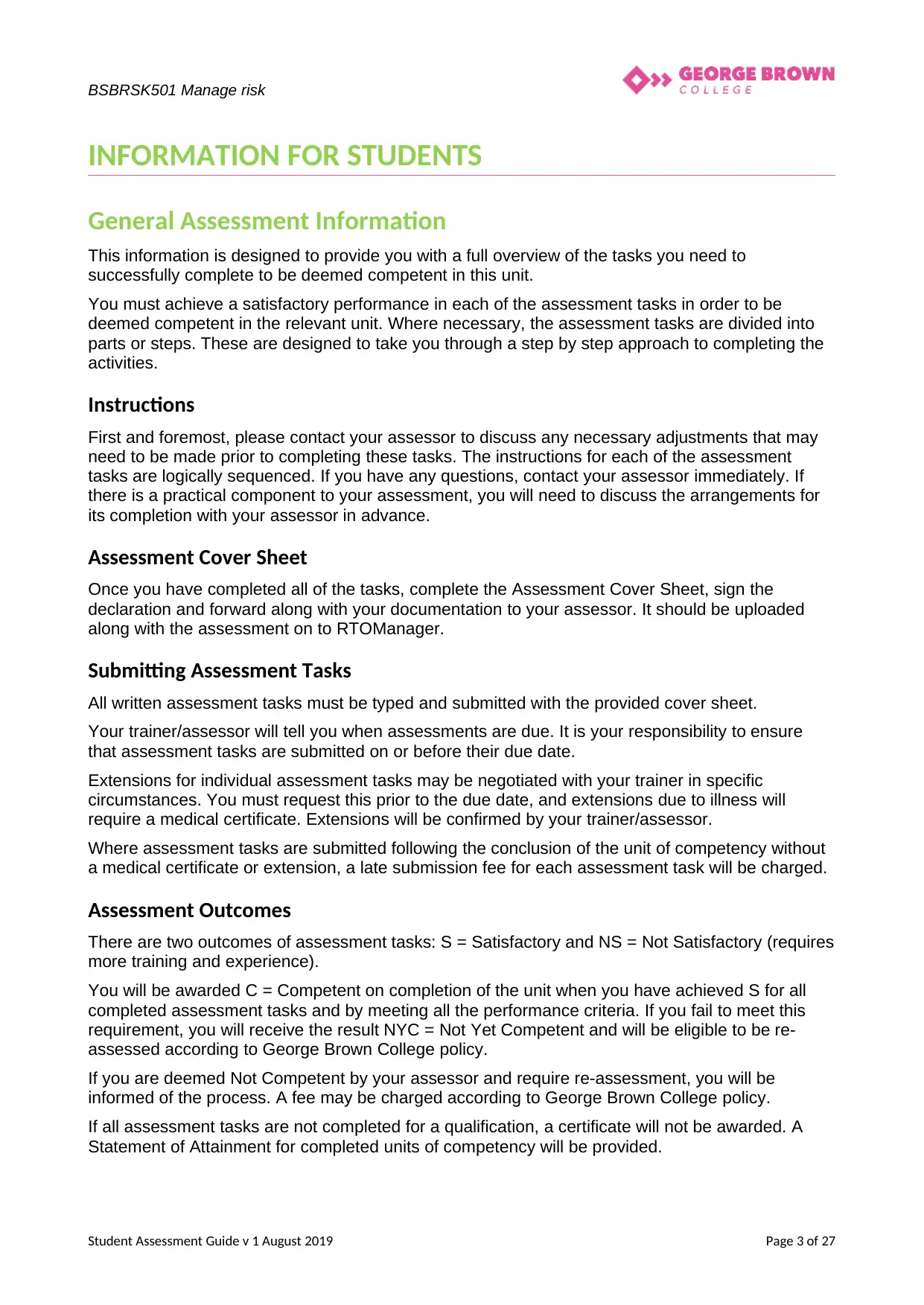
BSBRSK501 Manage risk
INFORMATION FOR STUDENTS
General Assessment Information
This information is designed to provide you with a full overview of the tasks you need to
successfully complete to be deemed competent in this unit.
You must achieve a satisfactory performance in each of the assessment tasks in order to be
deemed competent in the relevant unit. Where necessary, the assessment tasks are divided into
parts or steps. These are designed to take you through a step by step approach to completing the
activities.
Instructions
First and foremost, please contact your assessor to discuss any necessary adjustments that may
need to be made prior to completing these tasks. The instructions for each of the assessment
tasks are logically sequenced. If you have any questions, contact your assessor immediately. If
there is a practical component to your assessment, you will need to discuss the arrangements for
its completion with your assessor in advance.
Assessment Cover Sheet
Once you have completed all of the tasks, complete the Assessment Cover Sheet, sign the
declaration and forward along with your documentation to your assessor. It should be uploaded
along with the assessment on to RTOManager.
Submitting Assessment Tasks
All written assessment tasks must be typed and submitted with the provided cover sheet.
Your trainer/assessor will tell you when assessments are due. It is your responsibility to ensure
that assessment tasks are submitted on or before their due date.
Extensions for individual assessment tasks may be negotiated with your trainer in specific
circumstances. You must request this prior to the due date, and extensions due to illness will
require a medical certificate. Extensions will be confirmed by your trainer/assessor.
Where assessment tasks are submitted following the conclusion of the unit of competency without
a medical certificate or extension, a late submission fee for each assessment task will be charged.
Assessment Outcomes
There are two outcomes of assessment tasks: S = Satisfactory and NS = Not Satisfactory (requires
more training and experience).
You will be awarded C = Competent on completion of the unit when you have achieved S for all
completed assessment tasks and by meeting all the performance criteria. If you fail to meet this
requirement, you will receive the result NYC = Not Yet Competent and will be eligible to be re-
assessed according to George Brown College policy.
If you are deemed Not Competent by your assessor and require re-assessment, you will be
informed of the process. A fee may be charged according to George Brown College policy.
If all assessment tasks are not completed for a qualification, a certificate will not be awarded. A
Statement of Attainment for completed units of competency will be provided.
Student Assessment Guide v 1 August 2019 Page 3 of 27
INFORMATION FOR STUDENTS
General Assessment Information
This information is designed to provide you with a full overview of the tasks you need to
successfully complete to be deemed competent in this unit.
You must achieve a satisfactory performance in each of the assessment tasks in order to be
deemed competent in the relevant unit. Where necessary, the assessment tasks are divided into
parts or steps. These are designed to take you through a step by step approach to completing the
activities.
Instructions
First and foremost, please contact your assessor to discuss any necessary adjustments that may
need to be made prior to completing these tasks. The instructions for each of the assessment
tasks are logically sequenced. If you have any questions, contact your assessor immediately. If
there is a practical component to your assessment, you will need to discuss the arrangements for
its completion with your assessor in advance.
Assessment Cover Sheet
Once you have completed all of the tasks, complete the Assessment Cover Sheet, sign the
declaration and forward along with your documentation to your assessor. It should be uploaded
along with the assessment on to RTOManager.
Submitting Assessment Tasks
All written assessment tasks must be typed and submitted with the provided cover sheet.
Your trainer/assessor will tell you when assessments are due. It is your responsibility to ensure
that assessment tasks are submitted on or before their due date.
Extensions for individual assessment tasks may be negotiated with your trainer in specific
circumstances. You must request this prior to the due date, and extensions due to illness will
require a medical certificate. Extensions will be confirmed by your trainer/assessor.
Where assessment tasks are submitted following the conclusion of the unit of competency without
a medical certificate or extension, a late submission fee for each assessment task will be charged.
Assessment Outcomes
There are two outcomes of assessment tasks: S = Satisfactory and NS = Not Satisfactory (requires
more training and experience).
You will be awarded C = Competent on completion of the unit when you have achieved S for all
completed assessment tasks and by meeting all the performance criteria. If you fail to meet this
requirement, you will receive the result NYC = Not Yet Competent and will be eligible to be re-
assessed according to George Brown College policy.
If you are deemed Not Competent by your assessor and require re-assessment, you will be
informed of the process. A fee may be charged according to George Brown College policy.
If all assessment tasks are not completed for a qualification, a certificate will not be awarded. A
Statement of Attainment for completed units of competency will be provided.
Student Assessment Guide v 1 August 2019 Page 3 of 27
⊘ This is a preview!⊘
Do you want full access?
Subscribe today to unlock all pages.

Trusted by 1+ million students worldwide

BSBRSK501 Manage risk
Your Results
Your assessor is committed to providing you with detailed feedback on the outcomes of the
assessment and will provide guidance on areas for improvement. In most instances, you should
only need to complete the sections of the assessment that were deemed not satisfactory.
However, it is important to remember that depending on the task, it may be necessary to repeat the
whole task (for example presentations or the delivery of a training session).
You are entitled to view your results at any time by viewing them once they are uploaded on
RTOManager.
Reasonable Adjustment
George Brown College supports individual differences in the learning environment and provides
‘reasonable adjustment’ in training and assessment activities to support every learner. If you have
any special needs that make it difficult for you to complete your learning or assessments, you
should discuss this with your assessor beforehand and will be provided with reasonable
alternatives to assist you to complete the required tasks such as completing tests verbally or using
an interpreter.
What happens if you do not agree with the assessment result?
If you do not think the assessment process is valid, or disagree with the decision once it is made,
or believe that you have been treated unfairly, you can appeal. The first step is to discuss the
matter with your trainer.
If you still do not agree with the results, refer to the GBC Complaints and Appeals Policy and speak
to the Student Services Team.
Support
While we may not be in a position to assist you with language training or specific LLN training, our
assessors will work with you to ensure that you are supported throughout your qualification. If you
require individual tutoring this may attract an additional fee (see Student Handbook). Support may
be offered by your assessor, or for more specialist support you may need to contact GBC
administration.
A Note on Plagiarism and Referencing
Plagiarism is a form of theft where the work, ideas, inventions etc. of other people are presented as
your own. Information, ideas etc. quoted or paraphrased from another source such as the Internet,
must be acknowledged with “quotation marks” around the relevant words/sentences or ideas and
the source listed in brackets. You must also list the sources at the end of your assessment.
Sources of information, ideas etc. must be provided in alphabetical order by author’s surname
(including author’s full name, name of document/ book / internet etc. and year and place of
publishing) or may be included in brackets in the text.
As a general rule it is advisable to never copy another person’s work. Should it appear that a
student’s work has been copied or does not appear to be authentic, you will be asked to speak to
your Course Coordinator and required to re-submit it. A fee may be charged according to George
Brown College policy.
Contacting the RTO
If you should need further support or assistance please do not hesitate to contact The Student
Services Team.
Student Assessment Guide v 1 August 2019 Page 4 of 27
Your Results
Your assessor is committed to providing you with detailed feedback on the outcomes of the
assessment and will provide guidance on areas for improvement. In most instances, you should
only need to complete the sections of the assessment that were deemed not satisfactory.
However, it is important to remember that depending on the task, it may be necessary to repeat the
whole task (for example presentations or the delivery of a training session).
You are entitled to view your results at any time by viewing them once they are uploaded on
RTOManager.
Reasonable Adjustment
George Brown College supports individual differences in the learning environment and provides
‘reasonable adjustment’ in training and assessment activities to support every learner. If you have
any special needs that make it difficult for you to complete your learning or assessments, you
should discuss this with your assessor beforehand and will be provided with reasonable
alternatives to assist you to complete the required tasks such as completing tests verbally or using
an interpreter.
What happens if you do not agree with the assessment result?
If you do not think the assessment process is valid, or disagree with the decision once it is made,
or believe that you have been treated unfairly, you can appeal. The first step is to discuss the
matter with your trainer.
If you still do not agree with the results, refer to the GBC Complaints and Appeals Policy and speak
to the Student Services Team.
Support
While we may not be in a position to assist you with language training or specific LLN training, our
assessors will work with you to ensure that you are supported throughout your qualification. If you
require individual tutoring this may attract an additional fee (see Student Handbook). Support may
be offered by your assessor, or for more specialist support you may need to contact GBC
administration.
A Note on Plagiarism and Referencing
Plagiarism is a form of theft where the work, ideas, inventions etc. of other people are presented as
your own. Information, ideas etc. quoted or paraphrased from another source such as the Internet,
must be acknowledged with “quotation marks” around the relevant words/sentences or ideas and
the source listed in brackets. You must also list the sources at the end of your assessment.
Sources of information, ideas etc. must be provided in alphabetical order by author’s surname
(including author’s full name, name of document/ book / internet etc. and year and place of
publishing) or may be included in brackets in the text.
As a general rule it is advisable to never copy another person’s work. Should it appear that a
student’s work has been copied or does not appear to be authentic, you will be asked to speak to
your Course Coordinator and required to re-submit it. A fee may be charged according to George
Brown College policy.
Contacting the RTO
If you should need further support or assistance please do not hesitate to contact The Student
Services Team.
Student Assessment Guide v 1 August 2019 Page 4 of 27
Paraphrase This Document
Need a fresh take? Get an instant paraphrase of this document with our AI Paraphraser
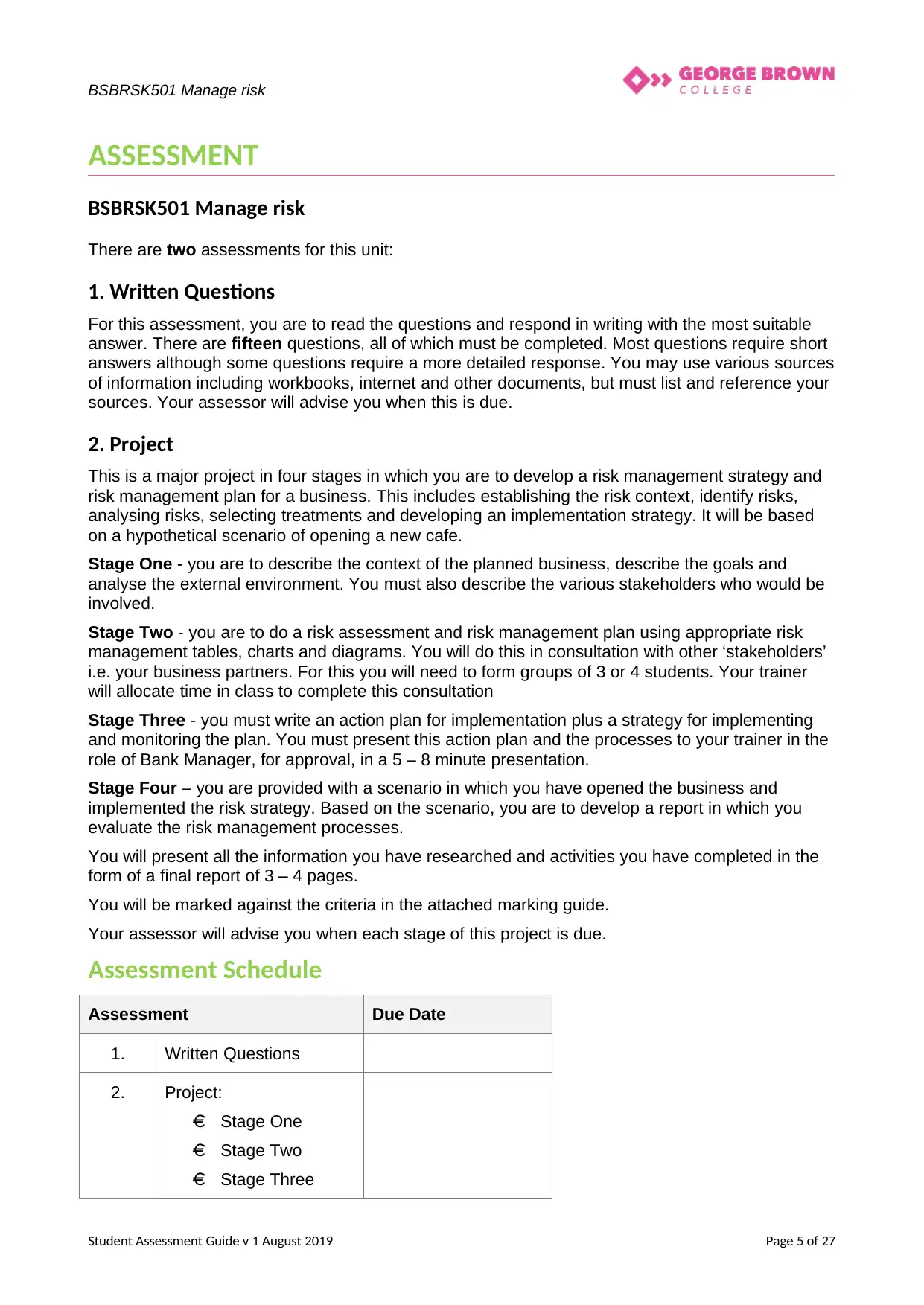
BSBRSK501 Manage risk
ASSESSMENT
BSBRSK501 Manage risk
There are two assessments for this unit:
1. Written Questions
For this assessment, you are to read the questions and respond in writing with the most suitable
answer. There are fifteen questions, all of which must be completed. Most questions require short
answers although some questions require a more detailed response. You may use various sources
of information including workbooks, internet and other documents, but must list and reference your
sources. Your assessor will advise you when this is due.
2. Project
This is a major project in four stages in which you are to develop a risk management strategy and
risk management plan for a business. This includes establishing the risk context, identify risks,
analysing risks, selecting treatments and developing an implementation strategy. It will be based
on a hypothetical scenario of opening a new cafe.
Stage One - you are to describe the context of the planned business, describe the goals and
analyse the external environment. You must also describe the various stakeholders who would be
involved.
Stage Two - you are to do a risk assessment and risk management plan using appropriate risk
management tables, charts and diagrams. You will do this in consultation with other ‘stakeholders’
i.e. your business partners. For this you will need to form groups of 3 or 4 students. Your trainer
will allocate time in class to complete this consultation
Stage Three - you must write an action plan for implementation plus a strategy for implementing
and monitoring the plan. You must present this action plan and the processes to your trainer in the
role of Bank Manager, for approval, in a 5 – 8 minute presentation.
Stage Four – you are provided with a scenario in which you have opened the business and
implemented the risk strategy. Based on the scenario, you are to develop a report in which you
evaluate the risk management processes.
You will present all the information you have researched and activities you have completed in the
form of a final report of 3 – 4 pages.
You will be marked against the criteria in the attached marking guide.
Your assessor will advise you when each stage of this project is due.
Assessment Schedule
Assessment Due Date
1. Written Questions
2. Project:
Stage One
Stage Two
Stage Three
Student Assessment Guide v 1 August 2019 Page 5 of 27
ASSESSMENT
BSBRSK501 Manage risk
There are two assessments for this unit:
1. Written Questions
For this assessment, you are to read the questions and respond in writing with the most suitable
answer. There are fifteen questions, all of which must be completed. Most questions require short
answers although some questions require a more detailed response. You may use various sources
of information including workbooks, internet and other documents, but must list and reference your
sources. Your assessor will advise you when this is due.
2. Project
This is a major project in four stages in which you are to develop a risk management strategy and
risk management plan for a business. This includes establishing the risk context, identify risks,
analysing risks, selecting treatments and developing an implementation strategy. It will be based
on a hypothetical scenario of opening a new cafe.
Stage One - you are to describe the context of the planned business, describe the goals and
analyse the external environment. You must also describe the various stakeholders who would be
involved.
Stage Two - you are to do a risk assessment and risk management plan using appropriate risk
management tables, charts and diagrams. You will do this in consultation with other ‘stakeholders’
i.e. your business partners. For this you will need to form groups of 3 or 4 students. Your trainer
will allocate time in class to complete this consultation
Stage Three - you must write an action plan for implementation plus a strategy for implementing
and monitoring the plan. You must present this action plan and the processes to your trainer in the
role of Bank Manager, for approval, in a 5 – 8 minute presentation.
Stage Four – you are provided with a scenario in which you have opened the business and
implemented the risk strategy. Based on the scenario, you are to develop a report in which you
evaluate the risk management processes.
You will present all the information you have researched and activities you have completed in the
form of a final report of 3 – 4 pages.
You will be marked against the criteria in the attached marking guide.
Your assessor will advise you when each stage of this project is due.
Assessment Schedule
Assessment Due Date
1. Written Questions
2. Project:
Stage One
Stage Two
Stage Three
Student Assessment Guide v 1 August 2019 Page 5 of 27

BSBRSK501 Manage risk
Stage Four
Student Assessment Guide v 1 August 2019 Page 6 of 27
Stage Four
Student Assessment Guide v 1 August 2019 Page 6 of 27
⊘ This is a preview!⊘
Do you want full access?
Subscribe today to unlock all pages.

Trusted by 1+ million students worldwide
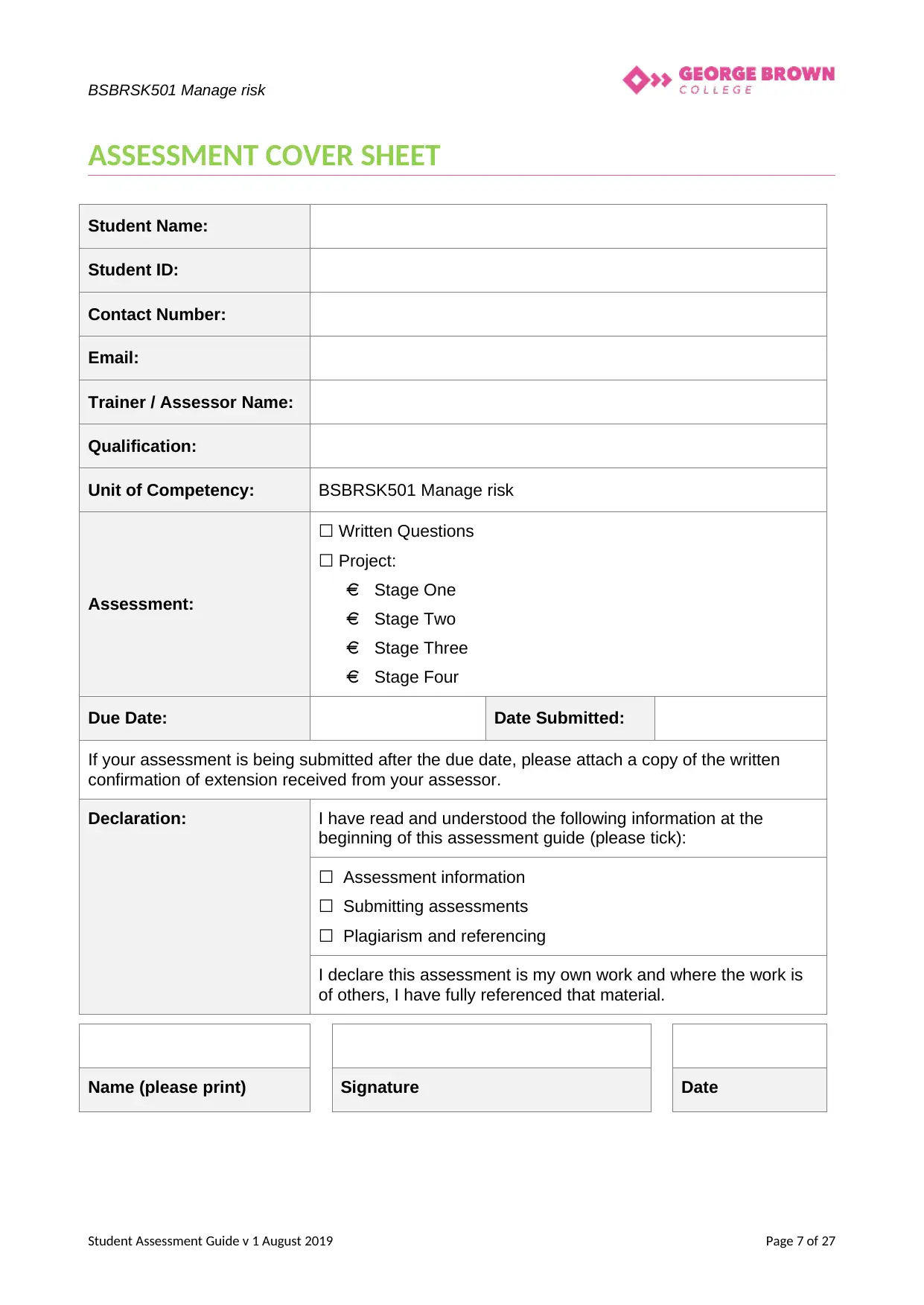
BSBRSK501 Manage risk
ASSESSMENT COVER SHEET
Student Name:
Student ID:
Contact Number:
Email:
Trainer / Assessor Name:
Qualification:
Unit of Competency: BSBRSK501 Manage risk
Assessment:
☐ Written Questions
☐ Project:
Stage One
Stage Two
Stage Three
Stage Four
Due Date: Date Submitted:
If your assessment is being submitted after the due date, please attach a copy of the written
confirmation of extension received from your assessor.
Declaration: I have read and understood the following information at the
beginning of this assessment guide (please tick):
☐ Assessment information
☐ Submitting assessments
☐ Plagiarism and referencing
I declare this assessment is my own work and where the work is
of others, I have fully referenced that material.
Name (please print) Signature Date
Student Assessment Guide v 1 August 2019 Page 7 of 27
ASSESSMENT COVER SHEET
Student Name:
Student ID:
Contact Number:
Email:
Trainer / Assessor Name:
Qualification:
Unit of Competency: BSBRSK501 Manage risk
Assessment:
☐ Written Questions
☐ Project:
Stage One
Stage Two
Stage Three
Stage Four
Due Date: Date Submitted:
If your assessment is being submitted after the due date, please attach a copy of the written
confirmation of extension received from your assessor.
Declaration: I have read and understood the following information at the
beginning of this assessment guide (please tick):
☐ Assessment information
☐ Submitting assessments
☐ Plagiarism and referencing
I declare this assessment is my own work and where the work is
of others, I have fully referenced that material.
Name (please print) Signature Date
Student Assessment Guide v 1 August 2019 Page 7 of 27
Paraphrase This Document
Need a fresh take? Get an instant paraphrase of this document with our AI Paraphraser
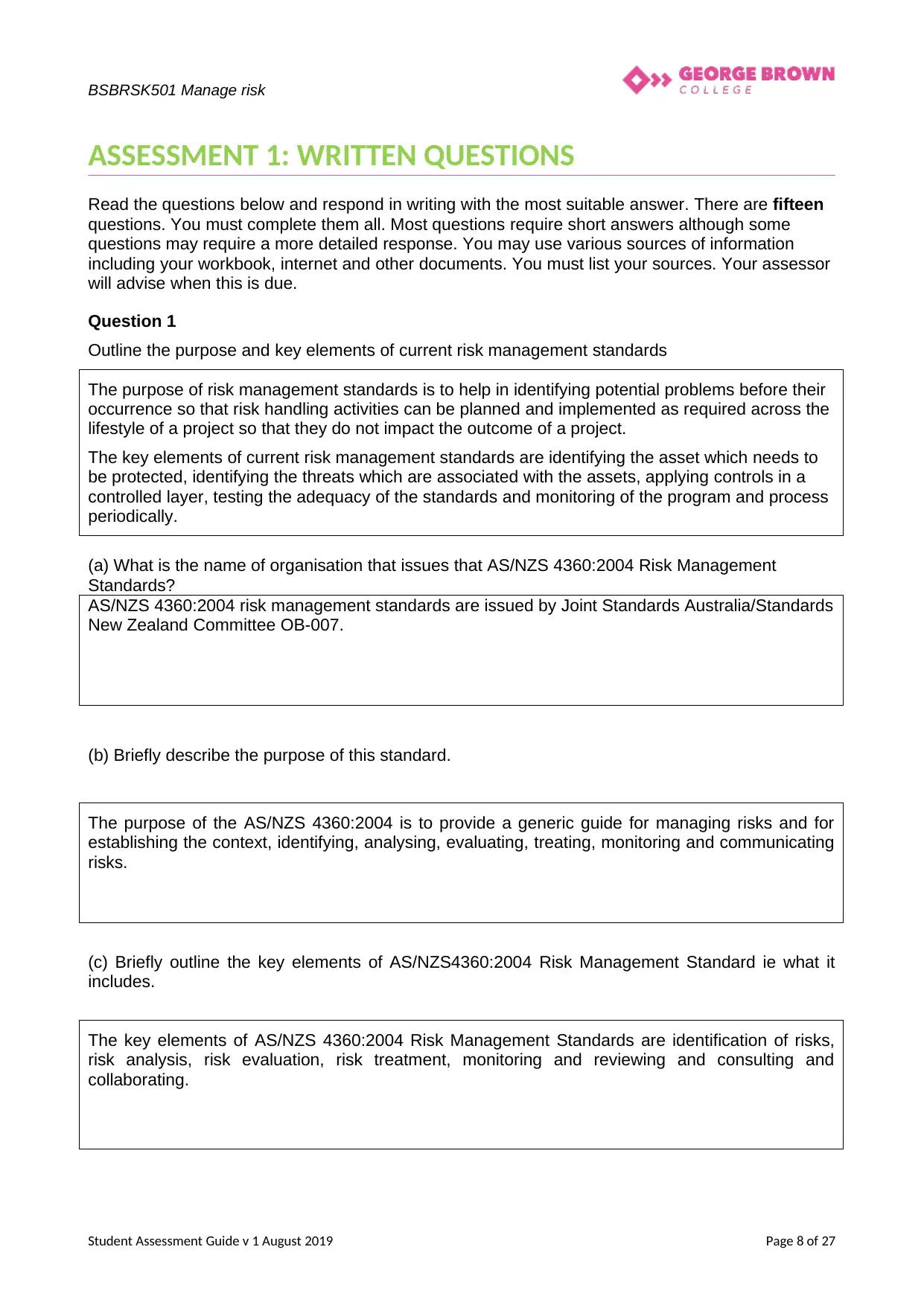
BSBRSK501 Manage risk
ASSESSMENT 1: WRITTEN QUESTIONS
Read the questions below and respond in writing with the most suitable answer. There are fifteen
questions. You must complete them all. Most questions require short answers although some
questions may require a more detailed response. You may use various sources of information
including your workbook, internet and other documents. You must list your sources. Your assessor
will advise when this is due.
Question 1
Outline the purpose and key elements of current risk management standards
The purpose of risk management standards is to help in identifying potential problems before their
occurrence so that risk handling activities can be planned and implemented as required across the
lifestyle of a project so that they do not impact the outcome of a project.
The key elements of current risk management standards are identifying the asset which needs to
be protected, identifying the threats which are associated with the assets, applying controls in a
controlled layer, testing the adequacy of the standards and monitoring of the program and process
periodically.
(a) What is the name of organisation that issues that AS/NZS 4360:2004 Risk Management
Standards?
AS/NZS 4360:2004 risk management standards are issued by Joint Standards Australia/Standards
New Zealand Committee OB-007.
(b) Briefly describe the purpose of this standard.
The purpose of the AS/NZS 4360:2004 is to provide a generic guide for managing risks and for
establishing the context, identifying, analysing, evaluating, treating, monitoring and communicating
risks.
(c) Briefly outline the key elements of AS/NZS4360:2004 Risk Management Standard ie what it
includes.
The key elements of AS/NZS 4360:2004 Risk Management Standards are identification of risks,
risk analysis, risk evaluation, risk treatment, monitoring and reviewing and consulting and
collaborating.
Student Assessment Guide v 1 August 2019 Page 8 of 27
ASSESSMENT 1: WRITTEN QUESTIONS
Read the questions below and respond in writing with the most suitable answer. There are fifteen
questions. You must complete them all. Most questions require short answers although some
questions may require a more detailed response. You may use various sources of information
including your workbook, internet and other documents. You must list your sources. Your assessor
will advise when this is due.
Question 1
Outline the purpose and key elements of current risk management standards
The purpose of risk management standards is to help in identifying potential problems before their
occurrence so that risk handling activities can be planned and implemented as required across the
lifestyle of a project so that they do not impact the outcome of a project.
The key elements of current risk management standards are identifying the asset which needs to
be protected, identifying the threats which are associated with the assets, applying controls in a
controlled layer, testing the adequacy of the standards and monitoring of the program and process
periodically.
(a) What is the name of organisation that issues that AS/NZS 4360:2004 Risk Management
Standards?
AS/NZS 4360:2004 risk management standards are issued by Joint Standards Australia/Standards
New Zealand Committee OB-007.
(b) Briefly describe the purpose of this standard.
The purpose of the AS/NZS 4360:2004 is to provide a generic guide for managing risks and for
establishing the context, identifying, analysing, evaluating, treating, monitoring and communicating
risks.
(c) Briefly outline the key elements of AS/NZS4360:2004 Risk Management Standard ie what it
includes.
The key elements of AS/NZS 4360:2004 Risk Management Standards are identification of risks,
risk analysis, risk evaluation, risk treatment, monitoring and reviewing and consulting and
collaborating.
Student Assessment Guide v 1 August 2019 Page 8 of 27
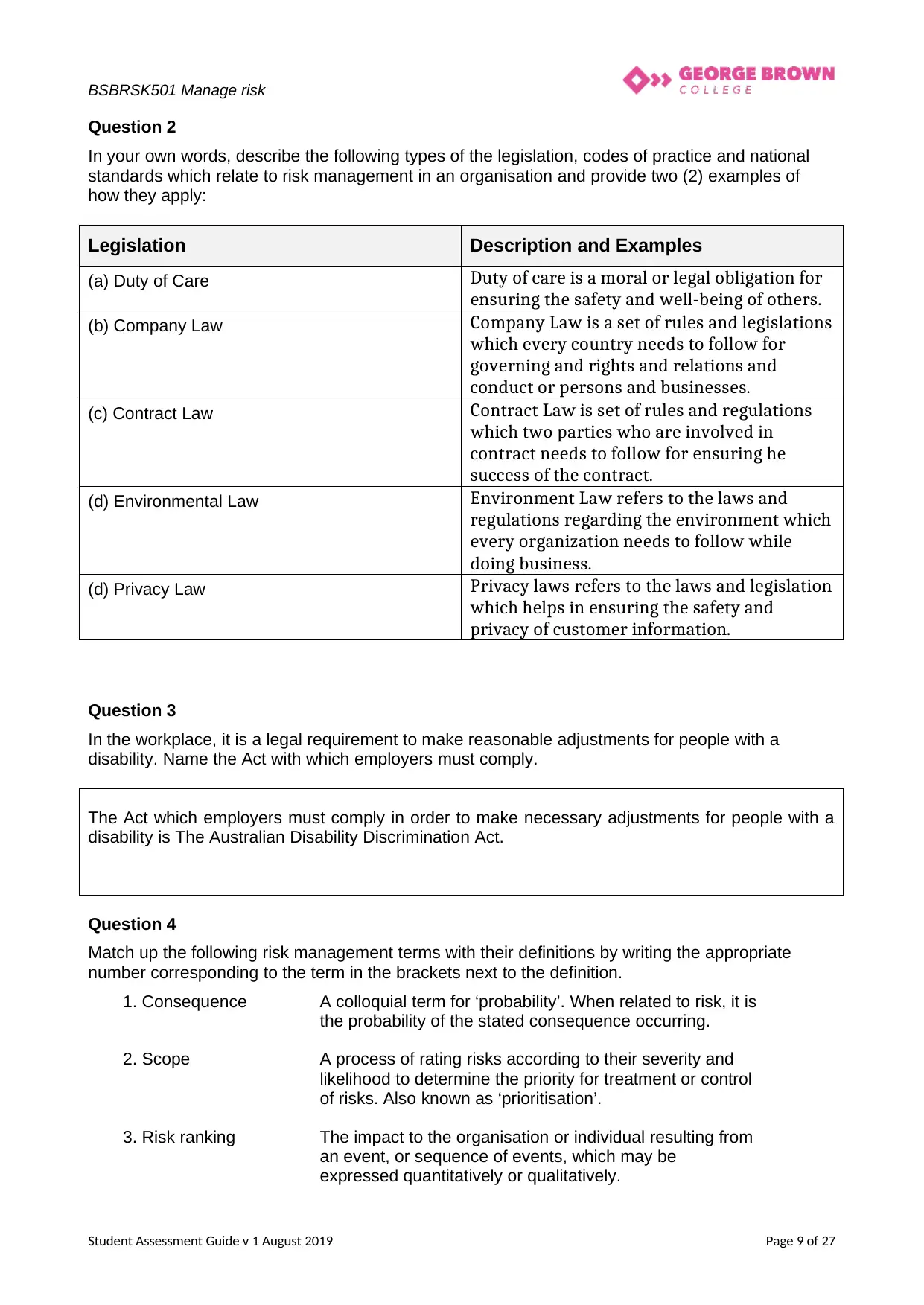
BSBRSK501 Manage risk
Question 2
In your own words, describe the following types of the legislation, codes of practice and national
standards which relate to risk management in an organisation and provide two (2) examples of
how they apply:
Legislation Description and Examples
(a) Duty of Care Duty of care is a moral or legal obligation for
ensuring the safety and well-being of others.
(b) Company Law Company Law is a set of rules and legislations
which every country needs to follow for
governing and rights and relations and
conduct or persons and businesses.
(c) Contract Law Contract Law is set of rules and regulations
which two parties who are involved in
contract needs to follow for ensuring he
success of the contract.
(d) Environmental Law Environment Law refers to the laws and
regulations regarding the environment which
every organization needs to follow while
doing business.
(d) Privacy Law Privacy laws refers to the laws and legislation
which helps in ensuring the safety and
privacy of customer information.
Question 3
In the workplace, it is a legal requirement to make reasonable adjustments for people with a
disability. Name the Act with which employers must comply.
The Act which employers must comply in order to make necessary adjustments for people with a
disability is The Australian Disability Discrimination Act.
Question 4
Match up the following risk management terms with their definitions by writing the appropriate
number corresponding to the term in the brackets next to the definition.
1. Consequence A colloquial term for ‘probability’. When related to risk, it is
the probability of the stated consequence occurring.
2. Scope A process of rating risks according to their severity and
likelihood to determine the priority for treatment or control
of risks. Also known as ‘prioritisation’.
3. Risk ranking The impact to the organisation or individual resulting from
an event, or sequence of events, which may be
expressed quantitatively or qualitatively.
Student Assessment Guide v 1 August 2019 Page 9 of 27
Question 2
In your own words, describe the following types of the legislation, codes of practice and national
standards which relate to risk management in an organisation and provide two (2) examples of
how they apply:
Legislation Description and Examples
(a) Duty of Care Duty of care is a moral or legal obligation for
ensuring the safety and well-being of others.
(b) Company Law Company Law is a set of rules and legislations
which every country needs to follow for
governing and rights and relations and
conduct or persons and businesses.
(c) Contract Law Contract Law is set of rules and regulations
which two parties who are involved in
contract needs to follow for ensuring he
success of the contract.
(d) Environmental Law Environment Law refers to the laws and
regulations regarding the environment which
every organization needs to follow while
doing business.
(d) Privacy Law Privacy laws refers to the laws and legislation
which helps in ensuring the safety and
privacy of customer information.
Question 3
In the workplace, it is a legal requirement to make reasonable adjustments for people with a
disability. Name the Act with which employers must comply.
The Act which employers must comply in order to make necessary adjustments for people with a
disability is The Australian Disability Discrimination Act.
Question 4
Match up the following risk management terms with their definitions by writing the appropriate
number corresponding to the term in the brackets next to the definition.
1. Consequence A colloquial term for ‘probability’. When related to risk, it is
the probability of the stated consequence occurring.
2. Scope A process of rating risks according to their severity and
likelihood to determine the priority for treatment or control
of risks. Also known as ‘prioritisation’.
3. Risk ranking The impact to the organisation or individual resulting from
an event, or sequence of events, which may be
expressed quantitatively or qualitatively.
Student Assessment Guide v 1 August 2019 Page 9 of 27
⊘ This is a preview!⊘
Do you want full access?
Subscribe today to unlock all pages.

Trusted by 1+ million students worldwide
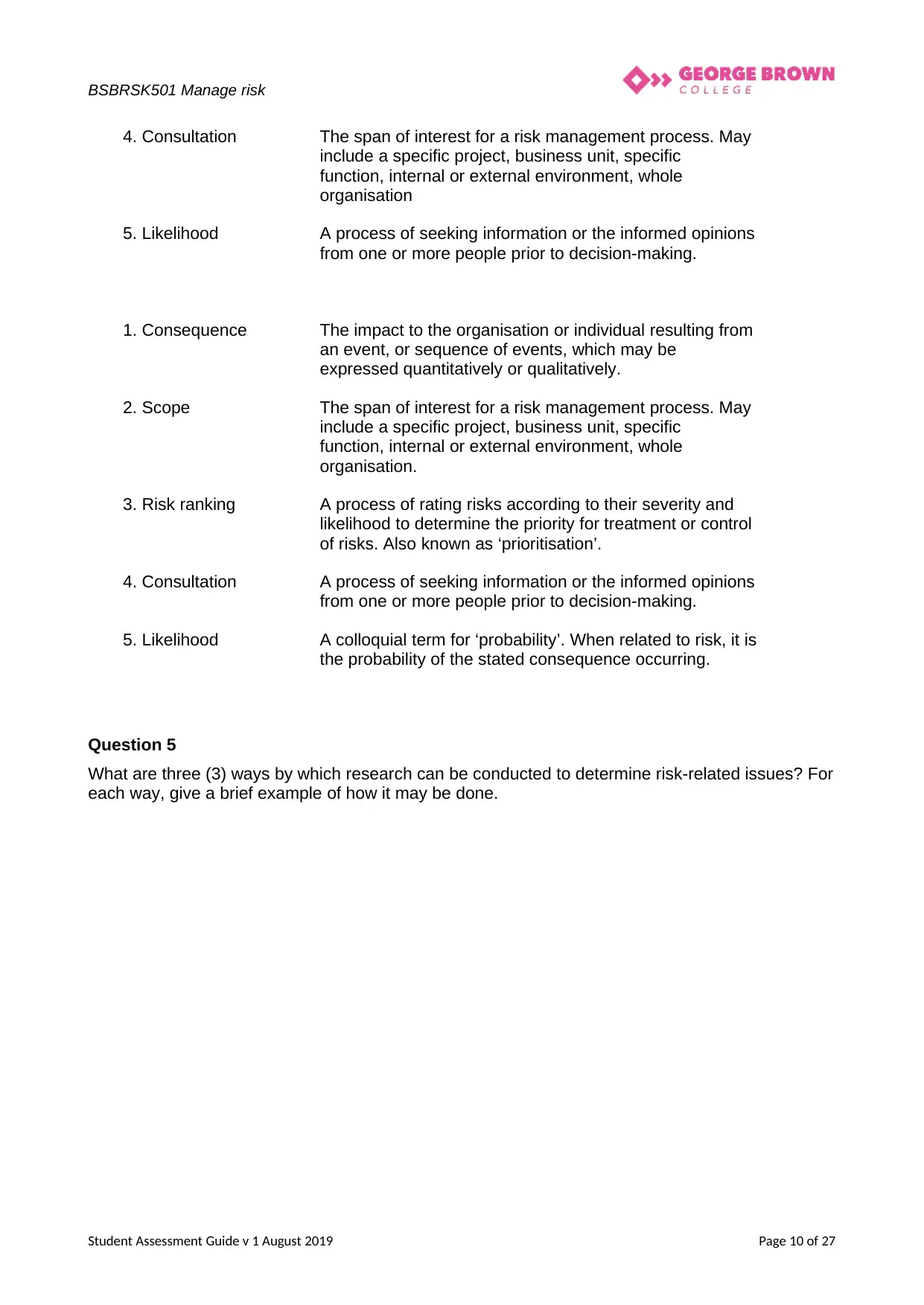
BSBRSK501 Manage risk
4. Consultation The span of interest for a risk management process. May
include a specific project, business unit, specific
function, internal or external environment, whole
organisation
5. Likelihood A process of seeking information or the informed opinions
from one or more people prior to decision-making.
1. Consequence The impact to the organisation or individual resulting from
an event, or sequence of events, which may be
expressed quantitatively or qualitatively.
2. Scope The span of interest for a risk management process. May
include a specific project, business unit, specific
function, internal or external environment, whole
organisation.
3. Risk ranking A process of rating risks according to their severity and
likelihood to determine the priority for treatment or control
of risks. Also known as ‘prioritisation’.
4. Consultation A process of seeking information or the informed opinions
from one or more people prior to decision-making.
5. Likelihood A colloquial term for ‘probability’. When related to risk, it is
the probability of the stated consequence occurring.
Question 5
What are three (3) ways by which research can be conducted to determine risk-related issues? For
each way, give a brief example of how it may be done.
Student Assessment Guide v 1 August 2019 Page 10 of 27
4. Consultation The span of interest for a risk management process. May
include a specific project, business unit, specific
function, internal or external environment, whole
organisation
5. Likelihood A process of seeking information or the informed opinions
from one or more people prior to decision-making.
1. Consequence The impact to the organisation or individual resulting from
an event, or sequence of events, which may be
expressed quantitatively or qualitatively.
2. Scope The span of interest for a risk management process. May
include a specific project, business unit, specific
function, internal or external environment, whole
organisation.
3. Risk ranking A process of rating risks according to their severity and
likelihood to determine the priority for treatment or control
of risks. Also known as ‘prioritisation’.
4. Consultation A process of seeking information or the informed opinions
from one or more people prior to decision-making.
5. Likelihood A colloquial term for ‘probability’. When related to risk, it is
the probability of the stated consequence occurring.
Question 5
What are three (3) ways by which research can be conducted to determine risk-related issues? For
each way, give a brief example of how it may be done.
Student Assessment Guide v 1 August 2019 Page 10 of 27
Paraphrase This Document
Need a fresh take? Get an instant paraphrase of this document with our AI Paraphraser
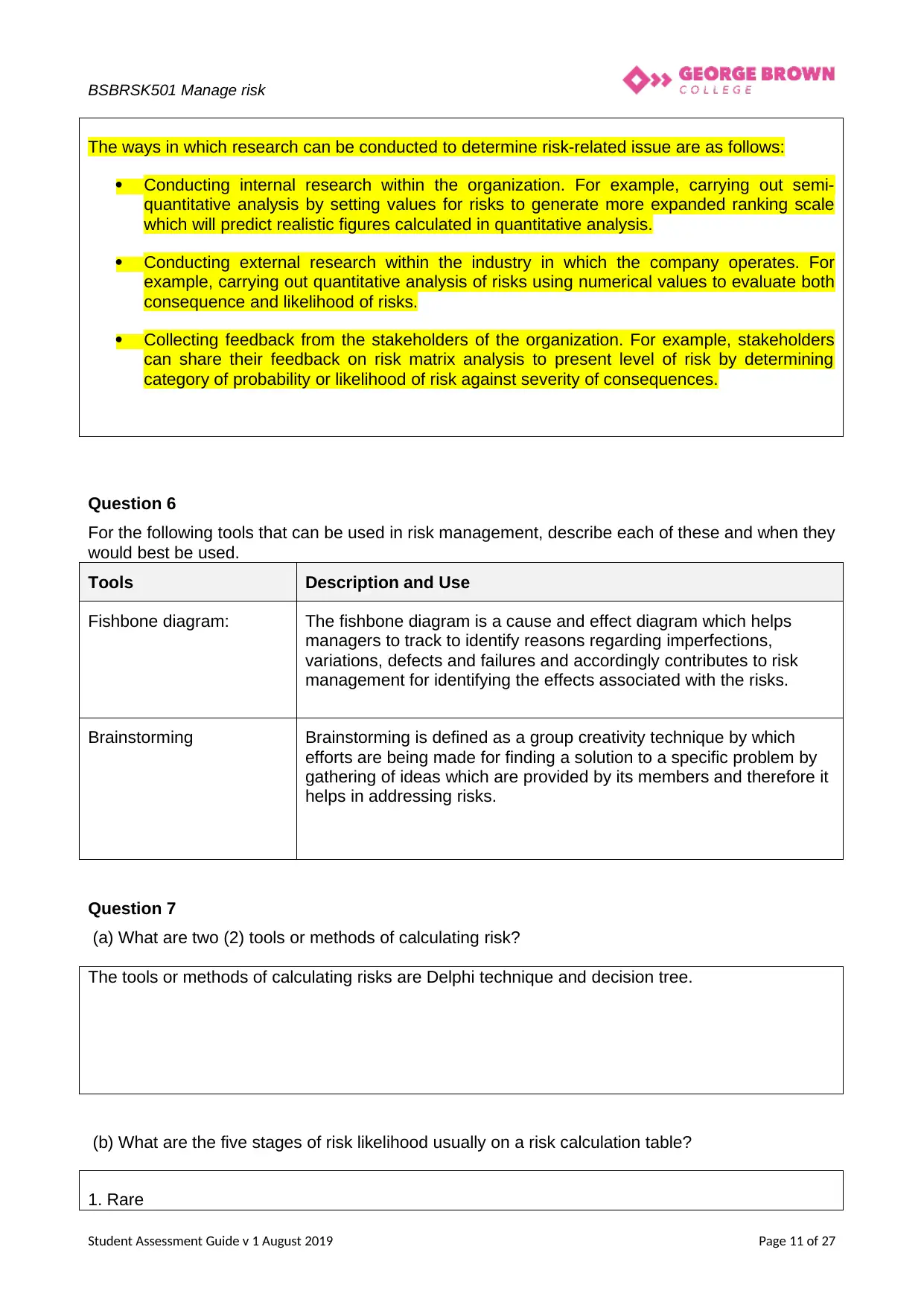
BSBRSK501 Manage risk
The ways in which research can be conducted to determine risk-related issue are as follows:
Conducting internal research within the organization. For example, carrying out semi-
quantitative analysis by setting values for risks to generate more expanded ranking scale
which will predict realistic figures calculated in quantitative analysis.
Conducting external research within the industry in which the company operates. For
example, carrying out quantitative analysis of risks using numerical values to evaluate both
consequence and likelihood of risks.
Collecting feedback from the stakeholders of the organization. For example, stakeholders
can share their feedback on risk matrix analysis to present level of risk by determining
category of probability or likelihood of risk against severity of consequences.
Question 6
For the following tools that can be used in risk management, describe each of these and when they
would best be used.
Tools Description and Use
Fishbone diagram: The fishbone diagram is a cause and effect diagram which helps
managers to track to identify reasons regarding imperfections,
variations, defects and failures and accordingly contributes to risk
management for identifying the effects associated with the risks.
Brainstorming Brainstorming is defined as a group creativity technique by which
efforts are being made for finding a solution to a specific problem by
gathering of ideas which are provided by its members and therefore it
helps in addressing risks.
Question 7
(a) What are two (2) tools or methods of calculating risk?
The tools or methods of calculating risks are Delphi technique and decision tree.
(b) What are the five stages of risk likelihood usually on a risk calculation table?
1. Rare
Student Assessment Guide v 1 August 2019 Page 11 of 27
The ways in which research can be conducted to determine risk-related issue are as follows:
Conducting internal research within the organization. For example, carrying out semi-
quantitative analysis by setting values for risks to generate more expanded ranking scale
which will predict realistic figures calculated in quantitative analysis.
Conducting external research within the industry in which the company operates. For
example, carrying out quantitative analysis of risks using numerical values to evaluate both
consequence and likelihood of risks.
Collecting feedback from the stakeholders of the organization. For example, stakeholders
can share their feedback on risk matrix analysis to present level of risk by determining
category of probability or likelihood of risk against severity of consequences.
Question 6
For the following tools that can be used in risk management, describe each of these and when they
would best be used.
Tools Description and Use
Fishbone diagram: The fishbone diagram is a cause and effect diagram which helps
managers to track to identify reasons regarding imperfections,
variations, defects and failures and accordingly contributes to risk
management for identifying the effects associated with the risks.
Brainstorming Brainstorming is defined as a group creativity technique by which
efforts are being made for finding a solution to a specific problem by
gathering of ideas which are provided by its members and therefore it
helps in addressing risks.
Question 7
(a) What are two (2) tools or methods of calculating risk?
The tools or methods of calculating risks are Delphi technique and decision tree.
(b) What are the five stages of risk likelihood usually on a risk calculation table?
1. Rare
Student Assessment Guide v 1 August 2019 Page 11 of 27

BSBRSK501 Manage risk
2. Unlikely
3. Possible
4.Likely
5 Almost certain
Question 8
List the five levels consequence or a risk likelihood and consequence analysis table. Describe
examples for each based on risk to a business.
1. Insignificant- Risks creates negligible impact.
2. Minor- Risks create minimal impacts
3. Moderate- Risks create controlled imapct
4. Major- Risks create high impact
5 Severe- Risks create devastating impacts.
Question 9
When treating risk, what are some control measures that could be considered? List and describe
three (3) treatments.
1.Risk response- It is a process of controlling identified risks.
2. Chinese Walls- It is an information barrier which is set up within an organization for preventing
conflicts of interests.
3. Audit trail- It is an information which is recorded by an information technology for the purpose of
helping a future investigation.
Question 10
List five (5) types of insurance an organisation could consider purchasing, and for each type,
describe the risks covered by the insurance and the benefit to the organisation.
1. Professional liability insurance- It helps in covering a business against negligence claims due
to harm which arises from mistakes or failure to perform.
2. Property insurance- Property insurance helps in covering equipment, signage, inventory and
furniture in case of fires, theft or natural disasters.
Student Assessment Guide v 1 August 2019 Page 12 of 27
2. Unlikely
3. Possible
4.Likely
5 Almost certain
Question 8
List the five levels consequence or a risk likelihood and consequence analysis table. Describe
examples for each based on risk to a business.
1. Insignificant- Risks creates negligible impact.
2. Minor- Risks create minimal impacts
3. Moderate- Risks create controlled imapct
4. Major- Risks create high impact
5 Severe- Risks create devastating impacts.
Question 9
When treating risk, what are some control measures that could be considered? List and describe
three (3) treatments.
1.Risk response- It is a process of controlling identified risks.
2. Chinese Walls- It is an information barrier which is set up within an organization for preventing
conflicts of interests.
3. Audit trail- It is an information which is recorded by an information technology for the purpose of
helping a future investigation.
Question 10
List five (5) types of insurance an organisation could consider purchasing, and for each type,
describe the risks covered by the insurance and the benefit to the organisation.
1. Professional liability insurance- It helps in covering a business against negligence claims due
to harm which arises from mistakes or failure to perform.
2. Property insurance- Property insurance helps in covering equipment, signage, inventory and
furniture in case of fires, theft or natural disasters.
Student Assessment Guide v 1 August 2019 Page 12 of 27
⊘ This is a preview!⊘
Do you want full access?
Subscribe today to unlock all pages.

Trusted by 1+ million students worldwide
1 out of 27
Related Documents
Your All-in-One AI-Powered Toolkit for Academic Success.
+13062052269
info@desklib.com
Available 24*7 on WhatsApp / Email
![[object Object]](/_next/static/media/star-bottom.7253800d.svg)
Unlock your academic potential
Copyright © 2020–2025 A2Z Services. All Rights Reserved. Developed and managed by ZUCOL.




